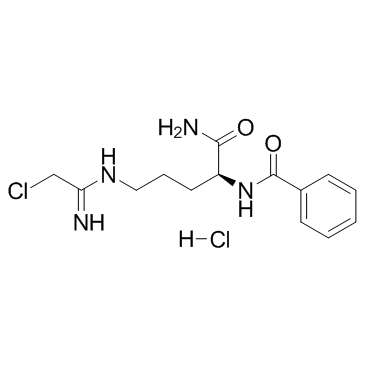1373232-26-8
| Name | N-{(2S)-1-Amino-5-[(2-chloroethanimidoyl)amino]-1-oxo-2-pentanyl}benzamide hydrochloride (1:1) |
|---|---|
| Synonyms |
N-{(2S)-1-Amino-5-[(2-chloroethanimidoyl)amino]-1-oxo-2-pentanyl}benzamide hydrochloride (1:1)
Benzamide, N-[(1S)-1-(aminocarbonyl)-4-[(2-chloro-1-iminoethyl)amino]butyl]-, hydrochloride (1:1) MFCD22201084 |
| Description | Cl-amidine (hydrochloride) is a peptidylarginine deminase (PAD) inhibitor, with an IC50 5.9 μM for PAD4. |
|---|---|
| Related Catalog | |
| Target |
IC50: 5.9 μM (PAD4)[1]. |
| In Vitro | Cl-amidine is a peptidylarginine deminase (PAD) inhibitor, with an IC50 of 5.9±0.3 μM for PAD4 and Cl-amidine is a bioavailable haloacetamidine-based compound that inhibits all the active PAD isozymes with near equal potency (kinact/KI=13,000 M-1.min-1 for PAD4)[1]. Cl-amidine induces apoptosis (identified as annexin V-positive/propidium iodide-negative cells) in such cells in a dose-dependent manner, indicating that Cl-amidine induces apoptosis of WBCs in vitro. Interestingly, the colon cancer cell line (HT29) is relatively resistant to apoptosis caused by Cl-amidine[2]. |
| In Vivo | Significantly higher levels of colon inflammation in the 2% DSS than the 2% DSS+Cl-amidine mice are showed. The mean histology scores are 24.2±1.7 (SE) and 13.9±1.6, respectively. Most of the damage in the DSS-only group is in the distal colon, and this damage is suppressed with DSS+Cl-amidine. For the DSS-treated group, the mean colon length is 7.2±0.2 cm. In contrast, the average colon length of the DSS+Cl-amidine group is 8.4±0.2 cm, which is comparable to the mean colon lengths obtained for the wateralone and water+Cl-amidine groups (8.4±0.3 and 7.9±0.2 cm, respectively). The total distance and average speed of mice over a 96-h period are also measured. The results of these analyses demonstrate that the total distance is 5,072±381 and 3,190±401 m for the water-treated and DSS+Cl-amidine mice, but only 800±163 m for the DSS-only group. Similarly, the average speed on the wheel over the 4-day period is 6.2±0.63 and 5.3±0.58 m/min for the water-treated and DSS+Cl-amidine groups, but only 1.8±0.51 m/min for the DSS group[2]. |
| Cell Assay | TK6 cells are a lymphoblastoid cell line derived from the spleen >30 years ago. HT29 cells are a colon cancer cell line, with mutant p53. TK6 lymphoblastoid cells and HT29 colon cancer cells are cultured with Cl-amidine in a dose-dependent manner (0, 5, 10, 15, 20, 25, 50 μg/mL) over 24 h. Apoptosis is assessed by annexin V/propidium iodide staining followed by flow cytometry[2]. |
| Animal Admin | Mice[2] C57BL/6 mice (8-12 wk old) are fed a standard AIN 93M diet. For this DSS mouse model of colitis, mice receive water ad libitum or 2% DSS beginning at day 0 for oral gavage/treatment experiment or day 7 for intraperitoneal/prevention experiment. Initial experiments used injections of Cl-amidine (75 mg/kg-1/day-1 ip), beginning concomitantly with the initiation of 2% DSS in the drinking water. This dose is chosen based on results in a RA model that used 100 mg/kg-1/day-1 without overt side effects and without immunosuppressive outcomes. In DSS model, 50 mice in 4 groups are examined, and inflammation scores are recorded[2]. |
| References |
| Molecular Formula | C14H20Cl2N4O2 |
|---|---|
| Molecular Weight | 347.240 |
| Exact Mass | 346.096344 |
| Storage condition | 2-8℃ |
